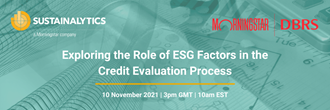What’s Happening in Sustainable Finance: Market Expectations Rise, Green Bonds Continue to Flourish, and Biodiversity Climbs Up the Agenda
Highlighting the growth of the global sustainable finance market during the first half of the year and the increasing attention on biodiversity among issuer and investors.
Exploring the Role of ESG Factors in the Fixed Income Investing Process
While many mainstream investors with an equity focus are applying ESG considerations as a part of their investment decision-making processes, how are fixed-income investors looking at ESG factors to assess corporate credit risk, bond selection, and other related activities?
The Impact and Cost of Air Pollution: U.S. Petroleum Refineries
Investors can examine to what extent petroleum refiners manage their Non-GHG Air Emissions and assess the quality of a company's programs to reduce air pollutants. For instance, examining all the petroleum refiners assessed by Sustainalytics, we observe that only 3% have a strong program to manage non-greenhouse gas emissions.
COP26 Goal #3 – Mobilize Finance
How can governments, companies and financial institutions help to mobilize finance to achieve global climate goals? Mayur Mukati of Sustainalytics’ Corporate Solutions unit discusses the role of sustainable finance in supporting a just and sustainable climate transition.
Momentum Around Principal Adverse Impact Data Remains Strong Despite SFDR Delays
Despite the shifting timelines, we observe that the market momentum around PAIs is not diminishing, quite the contrary. Investors in the scope of the regulation are using the fourth quarter of this year to get acquainted with PAI data and set up their systems. Most investors we speak with want to be prepared in time to be able to monitor PAIs throughout 2022 and adjust their portfolios to boost their PAIs (or rather limit the downside, as these are adverse impact indicators). This means that PAIs may significantly impact stock selection and portfolio construction by fund managers keen to have ‘good’ PAI scores.
SFDR and EU Taxonomy Product Disclosure Rules Finally Released
The publication of these rules marks the end of a prolonged period of uncertainty in the market around final rules and timelines - assuming the RTS will be adopted as-is in a Delegated Act, which turns these rules into regulation. There are several noteworthy aspects to these rules, which we address from our perspective in this article.
Biodiversity: A Crisis Equaling, Possibly Exceeding, Climate Change
According to the UN’s Convention on Biological Diversity the main drivers of biodiversity loss are habitat loss and degradation, climate change, pollution, over-exploitation, and invasive species. Habitat loss is directly linked to the conversion of natural ecosystems to agricultural lands and unsustainable use of water resources.
What’s Happening in Sustainable Finance: The Nuance of ESG Ratings, the Impact of Climate Change on Sport, and “Code Red” for Humanity
Discussing diverse sustainability and green finance topics including the momentum behind sustainability-linked bonds, the latest IPCC report as well as recent sustainable finance deals and transactions.
Bringing Investors and Companies Together to Accelerate Human Rights Progress
Human rights issues have been rising on the responsible investment agenda in recent years. The COVID-19 pandemic and the Black Lives Matter movement have provoked even more pointed discourse on the topic. The European Union’s current efforts to introduce rules to hold companies accountable for social and environmental risks in their supply chains further accelerate that ascent. This wave of legal requirements and normative expectations is impacting financial markets worldwide, with responsible business regulations already in place or quickly becoming valid.




















